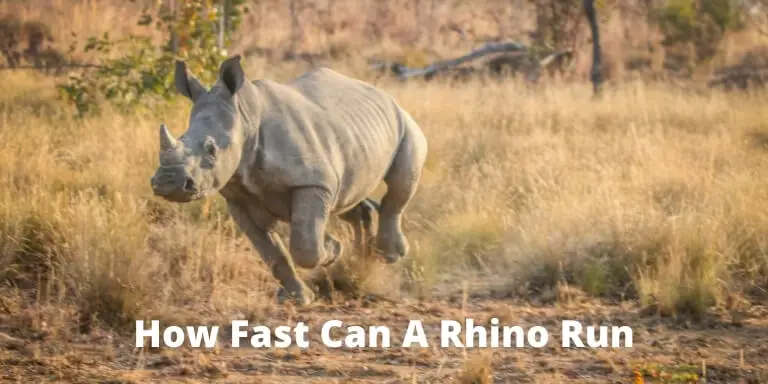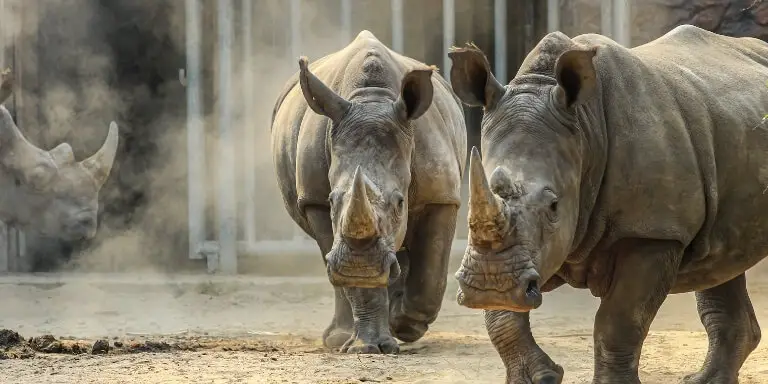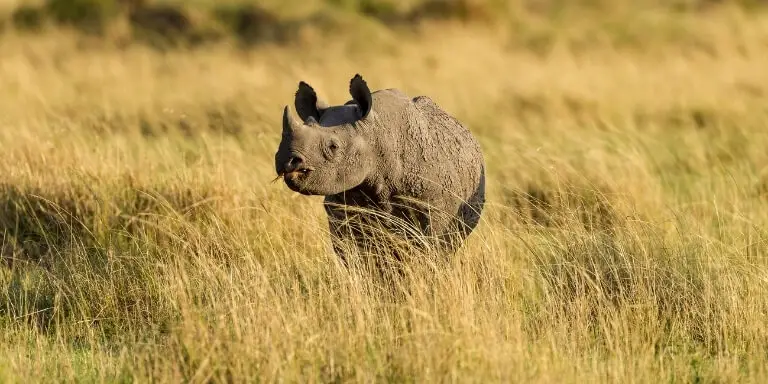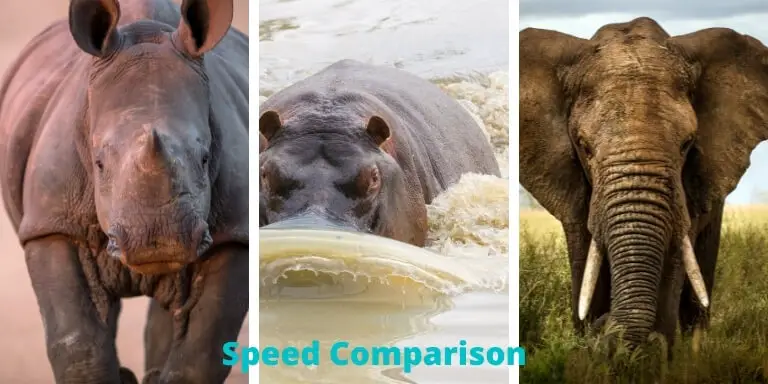Rhinoceros are the second biggest land mammal existing today. Almost all of the adults weigh more than a ton. Despite being so heavy they can easily surpass the speed of 50 km/h. The fastest rhinoceros ran at about 55 km/h. They run so fast that they almost feel like a tank made of flesh and blood with a large horn on the nose.
But is it possible to outrun a rhinoceros? Humans obviously aren’t so fast on foot. So if you see the horned beast charging towards you, you need to plan fast.

How fast can a Rhino run – All Species speed Comparison
5 species of rhinos are found in the world today. Their gait is calm while browsing for food. But they can run incredibly fast. It only takes a blink of an eye for them to reach the top speed. While walking they use their feet but running interestingly involves only the toes.

| Rhinoceros Species | Average Speed |
|---|---|
| White Rhinoceros | 45 Km/h |
| Black Rhinoceros | 55 Km/h |
| Indian | 55 Km/h |
| Sumatran | 40 Km/h |
| Javan | 48 Km/h |
White Rhinoceros
They are the biggest of all species and are found throughout the deserts of Africa. Their massive weight has caused them to slow down than their other cousins. But still, they can often surpass 40 to 50 km/h (25 to 30 mph).
Black Rhinoceros
They are the most ferocious of all species. They may not be as big as the white ones but they are the fastest. The black species can run up to a spectacular 55 km/h (top speed 34 mph). It is truly a wonder that something so big can run so fast. They also have the biggest horns in the family making them the most fearsome member.
Indian Rhinoceros
They are also known as the Greater One-Horned Ones. These massive herbivores are also considered to have a top speed of about 55 km/h (top speed 34 mph). But an average adult in the wild is seen to surpass the limit of about 40 km/h (25 mph) only. They still can be a lot dangerous if they attack from close range.
Sumatran Rhinoceros
They are the smallest family member. Sumatran Rhinios can run at about 40 km/h (25 mph). Their velocity is almost the same as their Indian cousins. But their top speed isn’t as much as the black ones.
Javan Rhinoceros
These species run at a pace of about 48 km/h (30 mph). That is the top speed recorded in the wild. The species are not as ferocious as the black ones and not as big as the white ones. Their horns are not the biggest either. But their impact can break your neck if you don’t plan fast after they start charging.
How fast can a Baby Rhino run

Hornless toddlers don’t run at 50 km/h speed. They run a lot slower. However, they start walking at a very tender age. A lot faster than most of the animals.
A baby can be seen walking within the first few hours of its birth which is crazy. There is no crawling in the lives of these giants.
However, they do not run at a surprising 50 km/h during the first year of their birth. That pace is gained usually by the adult ones. But babies are often seen running and playing alongside their mothers.
They are a playful bunch and may show excessive interest in detrimental things in the wild. As a result, many calves end up being dead within their first year on earth.
Why do Rhinoceroses charge?
The horned giant usually chases unfamiliar objects. They are a defensive bunch. They see something fishy moving in the woods and they chase it down. It’s as simple as that.
They have very poor eyesight. It doesn’t really help them much. But their sense of hearing and smell is keen. These are the organisms they depend on to locate the threat.
But the threat they consider isn’t often a threat at all. It may be an unfamiliar tree or a weirdly shaped termite mound.
They charge in a straight line and try to penetrate the threat using their keratin horn. Black rhinos are known as the most dangerous ones out there. These bunches are the most likely ones to charge without being provoked.
Again sometimes they are not even trying to charge rather they intend to run away from the threat they feel. But due to horrible vision, they end up chasing the object they want to flee from. As a result, terrible accidents take place in the wild.
The stone lookalike beast also can charge out of frustration. Sometimes they are seen to attack something repeatedly until it disintegrates.
Young animals also need to practice being an adult. Sometimes youngsters smash down trees and inanimate objects just to show off their strength.
However, whatever the reason may be behind their charging, it doesn’t really matter after the huge bulk starts to move. After that, you just need to think of surviving the massive moving thing and staying alive.
How to survive a chasing rhino

A rhino encounter in the wild can end up in a massive disaster if certain things are not looked after. However, it is certainly impossible to outrun the giant in the wild. It is impossible even if you’re a world-class athlete. For instance, the fastest man on planet Usain Bolt’s top momentum ever was recorded at 44.72 km/h.
That is certainly very impressive from a human point of view. But rhinos would be laughing in the wild discussing the fastest man ever to be slower than their average adult cousins.
Even if it is impossible to outrun the massive creature, it is possible to survive one’s attack. Here are 6 things that you could do if a rhino chased you.
- Run in a zigzag motion. The creature is bulky and massive. Use their huge weight against them. Stop running in a straight line. It would be easy for them to chase and hunt you down if you do so.
- Run up a hill or climb on a big rock. Get on high ground as soon as possible. Move your legs as fast as possible to avoid being smashed.
- Go and hide behind a rock or a termite mound if possible. Rhinoceros don’t possess binocular vision. This means if you stay out of sight for a while or stay still, the creature might lose interest to attack you. After all, they are not natural predators.
- Try running in the direction the wind is blowing. Rhinoceros locate their threats through their keen sense of smell. So if you run in the direction of the wind, your smell would also blow away and not reach their noses.
- Climb a tree if possible. But always be aware if the tree has a firm root or not. Because a weak tree can be massacred by these horned beasts with just a single blow.
- Avoid the creature if it is bowing its head and pointing the horn toward you. It means it wants to chase you down. So if a rhino in the wild is seen in such positions, turn around and leave the area immediately.
Rhino vs Hippo vs Elephant speed Comparison

| Comparison topic | Rhinoceros | Hippopotamus | Elephant |
|---|---|---|---|
| Weight | 1300 to 2700 kilograms | 1300 to 1800 kilograms | 2000 to 6000 kilograms |
| Top speed | 55 km/h | 48 km/h | 40 km/h |
| Average speed | 45 to 50 km/h | 30 km/h | 25 km/h |
Rhinos are the fastest mammals on earth weighing over a ton. Their huge tusks can move unimaginably fast. But it is not the pace that is surprising but the amount of time to reach the top speed is. They can reach from 0 to 50 km/h within the blink of an eye.
In comparison to other African giants such as hippos or elephants, their bulky neighbors are much faster. Though being the most aggressive animal of all, the top speed of a hippo is about 30 km/h.
Where the biggest land mammal is, the elephants can reach up to a stunning 40 km/h. But the horned warrior as usual tops them all.
Conclusion
The answer to the question of how fast can a rhino run is simple. The bulky giants are undoubtedly the fastest mammal alive. A lot faster than hippos and elephants. Black rhinos are known to be the fastest among all species.
But this massive pace is reached by an adult rhino only. This exciting speed can also be horrifying if the animal is chasing you down for hunting. So you need to be ready and be able to read the actions of the creature to act accordingly.
Related Articles:
Top 5 Predators that can kill Rhinos
Anti Rhino Poaching Guide
Rhino Life Cycle Explained
